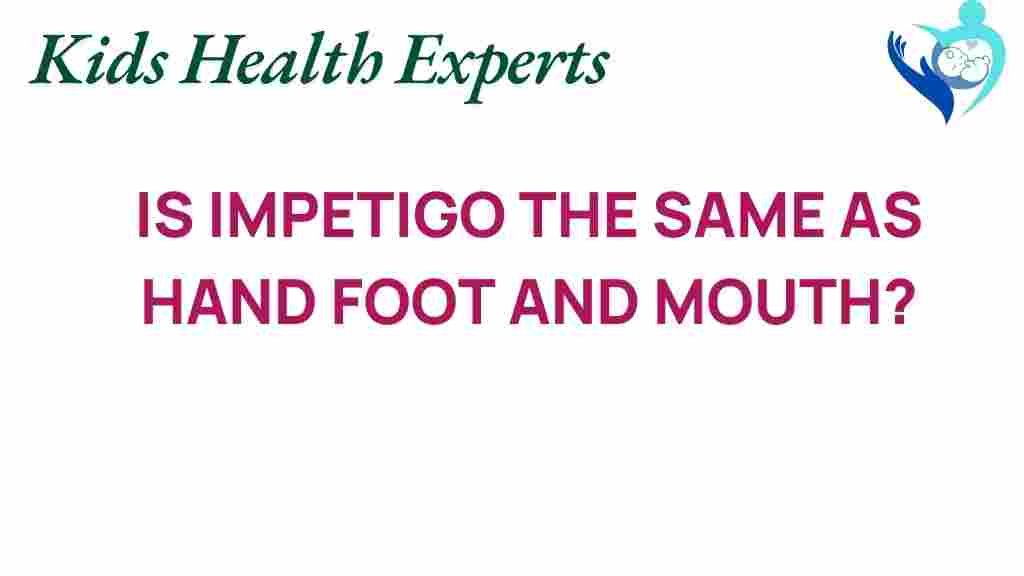Impetigo vs. Hand, Foot, and Mouth Disease: What’s the Difference?
Skin infections are common among children and can often lead to confusion among parents trying to understand the differences between various conditions. Two such infections that frequently cause concern are impetigo and hand, foot, and mouth disease. Although both conditions can appear similar, they have distinct causes, symptoms, and treatments. In this article, we will explore the differences between impetigo and hand, foot, and mouth disease, helping parents recognize and respond to these pediatric health issues effectively.
Understanding Impetigo
Impetigo is a highly contagious bacterial skin infection primarily caused by Staphylococcus aureus or Streptococcus pyogenes. It usually affects children aged 2 to 6 years but can occur in individuals of any age. Impetigo is characterized by the rapid development of blisters and sores that can burst and ooze, forming a honey-colored crust.
Symptoms of Impetigo
The symptoms of impetigo typically include:
- Red sores or blisters, often around the nose and mouth
- Oozing and crusting of the sores
- Itching or discomfort
- Swelling in the affected areas
Diagnosis of Impetigo
Diagnosing impetigo generally involves a physical examination by a healthcare provider. They will look for characteristic symptoms and may take a sample of the fluid from the sores to confirm the presence of bacteria.
Treatment for Impetigo
Treatment options for impetigo include:
- Topical antibiotics for mild cases
- Oral antibiotics for more severe or widespread infections
- Proper hygiene to prevent the spread of the infection
It’s important to keep the affected areas clean and to avoid touching the sores to minimize the risk of spreading the bacteria.
Understanding Hand, Foot, and Mouth Disease
Hand, foot, and mouth disease (HFMD) is a viral infection most commonly caused by coxsackievirus. It primarily affects children under 5 years old but can also occur in older children and adults. HFMD is characterized by sores in the mouth and a rash on the hands and feet.
Symptoms of Hand, Foot, and Mouth Disease
The symptoms of hand, foot, and mouth disease typically include:
- Fever
- Sore throat
- Painful sores in the mouth
- Rash on the hands and feet, which may blister
- Irritability in infants and toddlers
Diagnosis of Hand, Foot, and Mouth Disease
Diagnosing hand, foot, and mouth disease usually involves a physical examination. Healthcare providers will look for symptoms such as mouth sores and rashes. In some cases, laboratory tests may be conducted to confirm the diagnosis.
Treatment for Hand, Foot, and Mouth Disease
Currently, there is no specific treatment for hand, foot, and mouth disease. Management focuses on relieving symptoms:
- Over-the-counter pain relievers to reduce fever and discomfort
- Fluids to prevent dehydration
- Soft foods and cool liquids to ease mouth pain
Comparison of Impetigo and Hand, Foot, and Mouth Disease
While both impetigo and hand, foot, and mouth disease are skin infections that affect children, they differ significantly in several aspects:
Causes
Impetigo is caused by bacterial infections, while hand, foot, and mouth disease is viral in nature.
Symptoms
Symptoms of impetigo include red sores and blisters, primarily around the face and mouth, whereas hand, foot, and mouth disease presents with mouth sores and a rash on the hands and feet.
Contagiousness
Both conditions are contagious, but the modes of transmission differ:
- Impetigo spreads through direct contact with sores or contaminated objects.
- Hand, foot, and mouth disease spreads through respiratory droplets or direct contact with contaminated surfaces.
Treatment
Impetigo is treated with antibiotics, while hand, foot, and mouth disease typically requires supportive care.
Prevention of Skin Infections in Children
Preventing skin infections like impetigo and hand, foot, and mouth disease involves several key practices:
- Encourage regular handwashing with soap and water.
- Avoid sharing personal items such as towels or utensils.
- Keep skin clean and dry, especially in warm weather.
- Avoid close contact with infected individuals.
When to See a Doctor
Parents should seek medical attention if they notice:
- Persistent fever or worsening symptoms
- Signs of dehydration
- Rapid spread of sores or a rash
- Concern about the severity of symptoms
Troubleshooting Common Concerns
Parents may have several concerns when dealing with skin infections in children. Here are some common troubleshooting tips:
1. Identifying Symptoms
If you are unsure whether your child has impetigo or hand, foot, and mouth disease, observe the symptoms closely. Take note of the locations of sores and their appearance.
2. Managing Fever
For high fever associated with hand, foot, and mouth disease, use appropriate fever-reducing medications and ensure your child stays hydrated.
3. Preventing Spread
To prevent the spread of impetigo, keep your child at home until they are no longer contagious, typically 24 hours after starting antibiotics.
Conclusion
In summary, while both impetigo and hand, foot, and mouth disease are skin infections common in children, they are caused by different pathogens and require different approaches to treatment and management. Understanding the symptoms, diagnosis methods, and treatment options can empower parents to address these conditions proactively.
For more information on pediatric health and skin infections, you can visit this resource. If you suspect your child may have either condition, don’t hesitate to consult your healthcare provider for proper diagnosis and treatment.
This article is in the category Conditions and created by KidsHealthExperts Team
